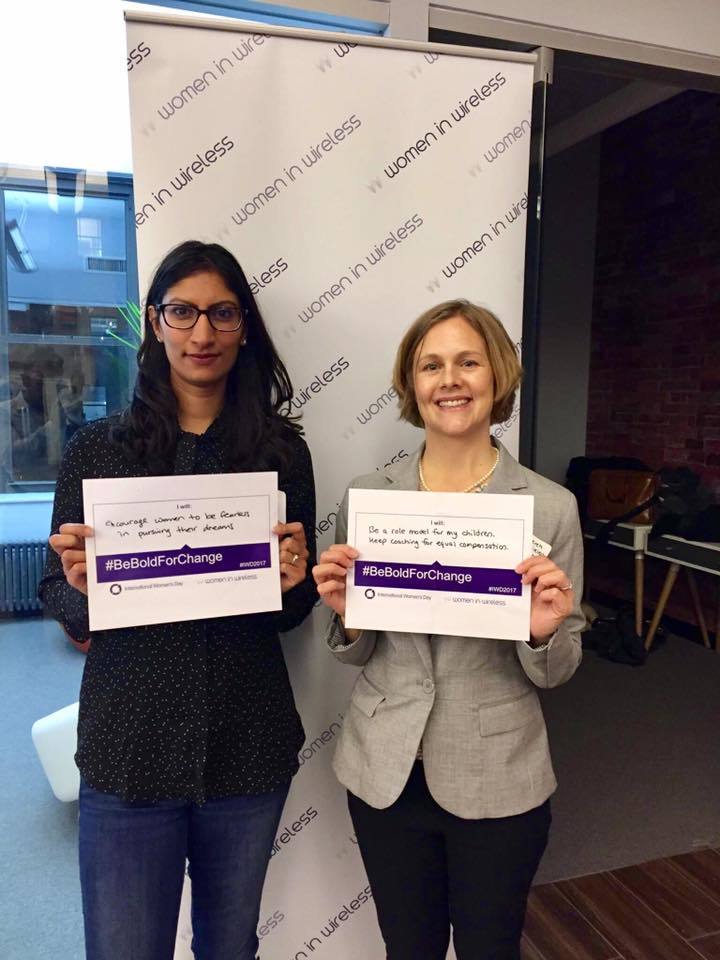
Farzana Nasser (left), co-president of Women In Wireless, with Jessica Ozrek, co-chair of WIW Global Talent team.
“Are there no other female founders?”
Farzana Nasser, co-president of Women in Wireless, tech entrepreneur and mobile and digital growth expert, says she mostly heard and saw only male founders of tech companies at conferences and in media.
So Nasser set out to change the ratios of male and female experts visible in the public sphere.
This month the non-profit Women in Wireless, that was founded in 2007 within the Mobile Marketing Association and became independent in 2011, launches MAD University, a series of courses, databases and free programs that support women in digital. Through the affiliated WIW Speakers Bureau, more than 100 women to date have been placed as speakers at tech conferences.
Women in Wireless has 12,000 members in 10 global chapters and partners with major mobile and tech conferences such as T-Mobile, Microsoft, and Facebook.
Nasser and co-president Sheryl Tullis, partner at Launch Consulting Group, say the mission is to offer “inspirational content and events, corporate partnerships and training programs, and networking opportunities with industry leaders."
According to the site, the goal is to “connect, inspire and embolden women across digital channels” with “membership that spans all career levels and disciplines and is open to everyone within the digital and mobile arenas.”
According to TechCrunch, relying on data from Crunchbase, “From 2009 to 2012, the percent of venture-funded companies with women founders increased by nearly 8 percent; however, the percentage of women-founded venture-backed companies has plateaued at approximately 17 percent since 2012. And as we look at Q1 2017 data, that percent doesn’t appear to have changed. For those who are keeping track, that’s nearly five years with no percentage growth in women-founded venture-backed startups.”
But the growth of female tech startups is rising.
“The absolute number of companies (along with the total number of startups) with a female founder grew more than fivefold, from 176 in 2009 to 932 in 2016. This 2016 result will grow as more women-founded startups with an initial funding are added to Crunchbase over the next year,” writes Gene Teare in TechCrunch.
Other stats about women in tech highlight a need for networking, support and recognition of the need for women to advocate for themselves as well as other women in order to address—and fill—the gender gap.
Sage Lazzarro writes in The Observer, “Women in tech face sexism and harassment. Tech is blatantly unfriendly to family planning, from being pregnant to nursing. There’s also a wage gap that no one is doing anything about—even Google, the second most valuable company in the world, recently said that collecting wage data for the company is too expensive and burdensome.”
Lazzarro adds these data points:
- Women own only 5 percent of startups.
- Women earn only 28 percent of computer science degrees.
- Only 7 percent of partners at top 100 venture capital firms are women.
- Women hold only 11 percent of executive positions at Silicon Valley companies.
- For women in the tech industry under age 25, earnings on average are 29 percent less than their male counterparts.
- About 74 percent of young girls express interest in STEM fields and computer science.
According to Nasser, advocating for all women in tech also includes advocating for yourself.
“It’s never too early to build your brand,” Nasser says. And she would know.
Nasser grew up in Toronto, after her father moved there following his family’s exile from Uganda in the Asian Expulsion of 1972. She went on to college, earning a BA in Business Administration from the Richard Ivey School of Business.
In 2009, Nasser moved to New York and graduated from New York University with a masters in Digital Marketing in 2012.
In 2013, she co-founded the tech start-up Gallop, a mobile technology company that uses behavioral data to intelligently target and optimize marketing and user acquisition efforts. The company was part of BNOTIONS, that was founded in 2005.
2013 was also the year she and her team entered the Facebook Innovation Competition.
“We had to put in a lot of effort and we focused the team on that,” Nasser says. “We made it to the final rounds, but we didn’t win. Our team was devastated. That was a huge failure. The next year the opportunity came and they were still devastated from the year before.”
Yes, she applied again. But this time, she says she was more confident and had learned from the failure. And yes, in 2014 her team won.
“If we hadn’t lost, we wouldn’t have won. That’s the best way to move forward.”
The Facebook win helped in establishing credibility, finding clients and building partnerships, Nasser says. “The recognition is validating.”
Validation both external and internal is what Nasser advises women entrepreneurs in tech and other fields seek for themselves.
“I was reliant on my managers and mentors to advocate for me. But other people are not advocating for you,” Nasser says. “I have found that every woman has experienced challenges in a male-dominated industry.” For all women entrepreneurs, Nasser recommends these tips:
- Find your authentic voice. “Women do not need to ask for permission to use their voices. Blog, post on social media, do public speaking, engage in thought leadership.” Nasser’s advice aligns with Leadership Power Tool # 8 created by Gloria Feldt, co-founder and president of Take The Lead, “Employ Every Medium.” Feldt writes, “Use personal, social, and traditional media every step of the way. Use the medium of your own voice. And think of each of the power tools as a medium to be pressed into the service of your “Power To.”
- Leverage your network. “Play a strong role in helping other women. Volunteer for a networking organization.”
- Be fearless. “I talk about my failures and women need to hear that. Have an appetite for failure. There are multiple failures before you achieve success.”
- Be comfortable with your style. “Embrace who you are. I have gotten feedback that I can be bossy or too demanding. I toned it down and tired to be someone I’m not so everyone is comfortable. But putting in that energy took away from the focus on the business.”
- Be candid. “I am upfront and say I am not going to sugarcoat anything. I say that not only do I want you to understand it is not personal, but I am honest and clear about expectations. It comes from a positive place.”
Since the birth of her daughter, Maya, who is now a year and a half old, Nasser says she finds herself even more inspired to do the work to help all women succeed in tech entrepreneurship.
“Because I had a daughter it’s motivating me so she never feels like there is an opportunity she will not be able to pursue.” Nasser adds,” She can achieve anything she wants.”
